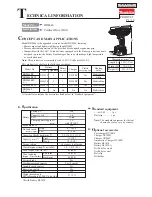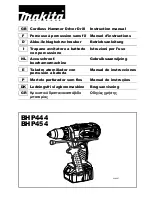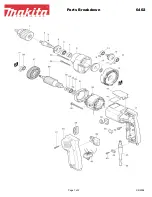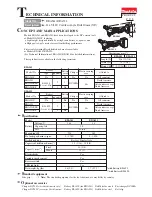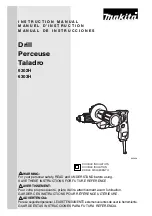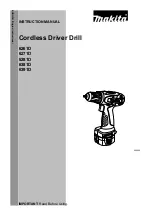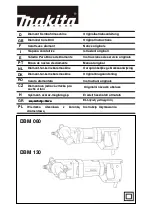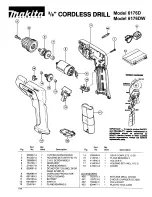
7 - English
OPERATION
TWO-SPEED GEAR TRAIN
See Figure 7, page 12.
Select
low speed
(1)
for applications such as drilling in
metal, and for applications requiring higher torque, such
as driving large screws.
Select high speed
(2)
for fast drilling or driving applica-
tions, for drilling in wood or masonry, and for hammer
drilling.
NOTICE:
Never change speeds while the tool is running.
Failure to obey this caution could result in serious
damage to the hammer drill.
NOTE:
If you have difficulty changing from one speed range
to the other, turn the chuck by hand until the gears engage.
ADJUSTING TORQUE
See Figure 8-9, page 12.
When using the hammer drill for various driving applications,
increasing or decreasing the torque helps prevent the pos-
sibility of damaging screw heads, threads, workpiece, etc.
In general, torque intensity should correspond to the screw
diameter. If the torque is too high or the screws too small, the
screws may be damaged or broken. The torque is adjusted
by rotating the clutch torque and mode selector ring.
The torque is greater when the clutch torque and mode
selector ring is set on a higher setting. The torque is less
when the clutch torque and mode selector ring is set on a
lower setting.
Rotate the adjustment ring to the proper torque setting for
the type of material and size of screw you are using.
• 1 - 4
For driving small screws
• 5 - 8
For driving screws into soft material
• 9 - 12
For driving screws into soft and hard
materials
• 13 - 16 driving screws into hard wood
• 17 - 22 For driving large screws
•
For heavy drilling
•
For drilling into masonry and concrete.
DRILLING/DRIVING SCREWS
See Figure 10, page 12.
Check the direction of rotation selector for the correct
setting (forward or reverse).
Select low
speed
(1)
or high
speed
(2)
, depending on
your application. Refer to
Two-Speed Gear Train
and
Adjusting Torque
.
Secure the workpiece in a vise or with clamps to keep it
from turning as the bit rotates.
Hold the hammer drill firmly and place the bit at the point
to be drilled, or where the screw is to be driven.
WARNING:
Battery tools are always in operating condition.
Lock the switch when not in use or carrying at your
side, when installing or removing the battery pack,
and when installing or removing bits.
INSTALLING/REMOVING BITS
See Figures 4 - 5, page 11.
The arrows on the keyless chuck indicate which direction
to rotate the chuck sleeve to tighten or release the drill bit.
Do not use a wrench to tighten or loosen the chuck jaws.
To install bits,
lock the switch trigger.
Open or close the chuck jaws until the opening is slightly
larger than the bit size you intend to use.
Raise the front of the hammer drill slightly and insert the
drill bit.
WARNING:
Make sure to insert the drill bit straight into the
chuck jaws. Do not insert the drill bit into the
chuck jaws at an angle, then tighten. This could
cause the drill bit to be thrown from the hammer
drill, resulting in possible serious personal injury
or damage to the chuck.
Rotate the chuck sleeve to close and tighten the chuck
jaws.
WARNING:
Do not hold the chuck sleeve with one hand and
use the power of the hammer drill to tighten the
chuck jaws on the drill bit. The chuck sleeve
could slip in your hand, or your hand could slip
and come in contact with the rotating drill bit.
This could cause an accident resulting in serious
personal injury.
To remove bits,
lock the switch trigger and open the
chuck jaws.
The bit provided with the hammer drill can be placed in
the storage area, located on the base of the hammer drill
(not included).
LED LIGHT
See Figure 6, page 12.
The LED light, located on the front of the tool base, illumi-
nates when the switch trigger is depressed.
The led light will turn off when switch trigger is released.
The led light illuminates only when there is a charged battery
pack in the tool.























